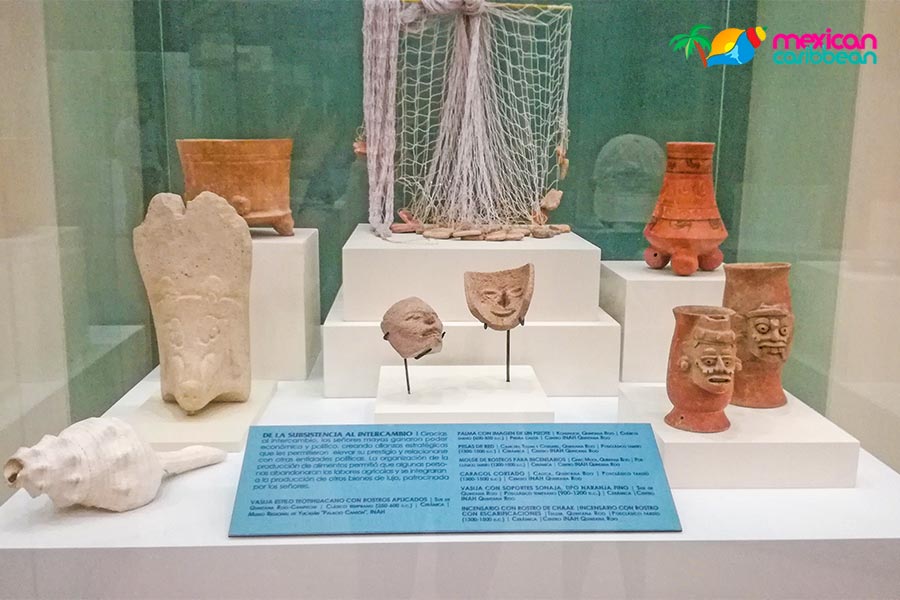The Mayam museum of Cancun is the most important new development that ran the National Institute of Anthropology and History of Mexico since the construction of the National Museum of Anthropology in Mexico City (1964 ) and the Museo del Templo Mayor ( 1987). It houses one of the archaeological collections of the most significant culture of the country , because not only include the most relevant state of Quintana Roo pieces, but a selection of iconic pieces of the sites of Palenque, Chichén Itzá, and Comalcalco , among other places represented.
The building of this museum , was designed carefuly with the environment , by architect Alberto García Lascurain . The outdoor spaces allow visitors to enjoy the climate of the city of Cancun , with large open areas . Access to the museum is chaired by a sculpture by the Dutch artist Jan Hendrix, representing the surroundings of the region on a water surface .

The exhibition space is eight meters high and includes three exhibition halls . The showrooms are within the walls also define the surrounding walkways and feature coated high strength glass for hurricanes , which allow a magnificent view of the forest of San Miguelito and Nichupte lagoon spaces
The Visit to the Museum also includes access to the archaeological site of San Miguelito , through a path of the lower corridor of the museum , this site consists of at least four sets consist primarily of structures that held wooden houses and palm , where families lived during the last years before the arrival of the Spanish conquistors.
The most important groups are chaired by palaces with spacious interiors and a lobby with columns supporting a flat roof , an architectural innovation characteristics built between the thirteenth and sixteenth centuries in the east coast of Quintana Roo buildings. These buildings had public functions, they were open enclosures , equipped with benches , where ceremonies and meetings the population participated.

The most important structure in San Miguelito is a foundation that was remodeled at least three times during prehistoric occupation , on which the remains of a temple are preserved , which once was decorated with a cornice and predominantly painted in red and blue. The basement has a staircase with balustrades , very characteristic of the Postclassic period and faces a set of structures , based on the orientation of the pyramid, appear to have been related to the site of El Rey .
History Museum of Maya Cancun
The first Archaeological Museum of Cancun , originally housed in the Center of the city , was opened in 1982 , in order to disseminate to local , national and international visitors the culture of pre-Hispanic Maya settled in the North state of Quintana Roo. In September 1988 , the small museum suspended their activities due to the serious damage caused to the building by the onslaught of Hurricane Gilbert , reopening its doors in July 1994. The successive hurricanes that struck the coast of Quintana Roo again damaged the building and the museum had to close down in 2004.
Six years later , began construction of the new Maya Museum of Cancun, designed with great respect and in harmony with the pre-Hispanic structures and landscape of the archaeological site of San Miguelito (1250-1550 AD ), which also opens with the Fine enclosure , thus forming a large set of just over 80 acres opened by the President of the Republic on November 2, 2012 .

Topics addressed in the Maya Museum of Cancun
The first room of the museum is dedicated to the archeology of Quintana Roo. His chronological journey begins with the oldest burials have been found in underwater caves of Quintana Roo coast , through the story of the monumental sites south of the state, until the rise of the northern region of the state or East Coast prior to arrival of the Spanish conquistadors . The pieces reflect the origin, development and change strategies in various cities, the funeral rites , architectural elements , ritual and domestic objects used by the Maya of Quintana Roo over two thousand years of history. The room closes with a brief outline of the conquest , the colonial era and the Caste War that took place during the nineteenth century.
The second room abounds on general aspects of Maya civilization : their relationship with the environment, the origin, development and decline of their cities, their economic activities from agriculture to trade , the characteristics of the ruling elites and the wars between them, the most important cultural expressions as writing and the calendar and some of their rituals as the ball game . The pieces displayed here are from both excavations in Quintana Roo , as well as in other Mexican states spanning the Maya area : Tabasco, Yucatan , Campeche and Chiapas. Some of these works have been granted loan by the site Comalcalco Museum , the Museo Regional de Yucatán " Palacio Canton " , the Museum site of Chichen Itza, the Regional Museum of Chiapas and Palenque Site Museum " Alberto Ruz L' huillier " .
The third and final room is devoted to the presentation of temporary exhibitions
Accessibility
In the Maya Museum of Cancun 's accessibility for people with special abilities.
This museum has the following services: shop, bookstore , cafeteria, educational services and nursing packages saved .
Schedule
Tuesday to Sunday from 9 to 18 hours. Thursdays from 9 to 18 hours.
The Mayan museum of Cancun is located in the boulevard kukulcan km 16 in the Cancun hotel zone, next to the hotel Omni.